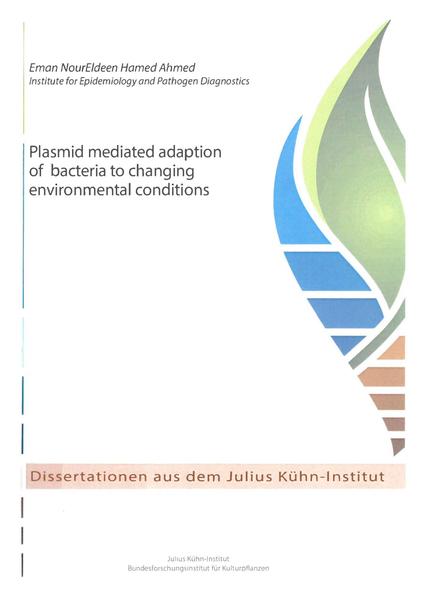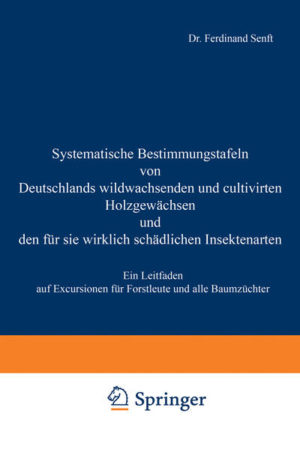- Softcover: 169 Seiten
- Verlag: Bundesforschungsinstitut für Kulturpflanzen (JKI)
- Autor: Eman Nour Eldeen Hamed Ahmed
- Auflage: 1. Aufl., erschienen am 15.09.2016
- ISBN-10: 3-95547-039-3
- ISBN-13: 978-3-95547-039-5
- Größe und/oder Gewicht: 21,0 x 14,0 cm
Plasmid mediated adaption of bacteria to changing environmental conditions
Autoren: Eman Nour Eldeen Hamed Ahmed12,95 €

HONIGHÄUSCHEN (BONN) – Conjugative plasmids have been frequently reported to carry a considerable variety of bacterial functional genes often coding for traits beneficial to the plasmid host. Transferable plasmids are mobile genetic elements (MGEs) that can transfer by conjugation or mobilization between bacterial cells of the same species or between different taxa. The ability to stably replicate in a host cell determines the replication range. Under rapidly changing environmental conditions plasmids foster the adaptation to stressful environments. The focus of this thesis was to investigate the response of bacterial communities to changing environmental conditions, and the studies showed that lncP-1 plasmid-mediated adaptation to changing environmental conditions is important for biofilter and rhizosphere bacteria. lncP-1 plasmids have a broad host range and transfer efficiently in soils and related habitats. lncP-1 plasmids have the ability to disseminate remarkably diverse functional genes (resistance to antibiotic and/or heavy metal, degradation of xenobiotics) by carrying, or mobilizing plasmids carrying, such genes via a process called horizontal gene transfer (HGT) or the proliferation of lncP-1 carrying bacterial populations. Most of the studied lncP-1 plasmids were isolated from polluted environments. However, the role of lncP-1 plasmids in unpolluted soils was so far not studied. In this context, this thesis is providing insights into the presence, response, type, diversity and potential ecological role of lncP-1 plasmids in two different environments known to be hot spots for HGT. First, on-farm bio-purification systems (BPSs) are an efficient, applicable, simple and low-cost method used by the farmers to treat pesticide-contaminated wastewater through biodegradation and sorption processes. Recently it was shown for on-farm BPSs that during the agricultural season the abundance of lncP-1 plasmids in BPS material increased and the dynamic changes of the composition of different lncP-1 plasmids were revealed by trfA amplicon sequencing. The increase of lncP-1 plasmids seemed to correlate with increasing pesticide concentration. In this thesis microcosm experiments were performed with BPS material where the phenylurea herbicide linuron was added or not. Cultivation-independent methods were used to study the dynamic response of BPS bacterial communities to the addition of linuron. Total community DNA (TC-DNA) extracted from BPS samples taken at different time points after the linuron addition was analyzed by quantitative real-time PCR or by PCR amplification of degradative genes and subsequent Southern blot hybridization. In addition, plasmids were captured in socalled exogenous biparental matings into P. putida as a recipient. The experimental design allowed to demonstrate the link between the presence of linuron and the abundance of lncP-1 plasmids and genes coding for enzymes involved in the degradation of linuron (chapters II and Ill). In three transconjugants the presence of hy/A gene was revealed. Second, the ecology of lncP-1 plasmid in the rhizosphere of three different crops grown under greenhouse conditions in the same soil type was investigated. We could confirm by qPCR the recently reported observation that in the rhizosphere of field-grown lettuce lncP-1 plasmids were enriched. In contrast, the increased relative abundance of lncP-1 plasmids was less pronounced in the rhizosphere of tomato and hardly detectable in potato plants (chapters IV and V). Based on the ability to mobilize lncQ plasmids, numerous lncP-1 plasmids were captured in a so-called triparental mating directly from rhizosphere bacteria. Transconjugants were selected based on the markers of the lncQ plasmid but most of the transconjugants also carried lncP-1 plasmids. The cultivation-independent methods used in this thesis (DGGE, pyrosequencing of 16S rRNA gene fragments, amplicon pyrosequencing of lncP-1 trlA genes, qPCR, PCR and/or Southern blot hybridization) allowed us to explore the dynamics of populations bearing lncP-1 plasmids in the TC-DNA of tested samples. The results presented in this thesis revealed that the lncP-1 plasmids bearing populations are remarkably dynamic in response not only to the introduction of xenobiotic compounds but also to plant root exudates providing evidence of the importance of lncP-1 plasmids in bacterial adaptation to both man-made and root exudates. Almost all lncP-1 subgroups were presented in all tested samples while lncP-113 subgroup showed a notably stronger response. We showed for the first time the high diversity of lncP-1 plasmids (particularly lncP-113 subgroup) regarding the rhizosphere of naturally grown lettuce and tomato plants but not for potato. Additionally, different plants might harbor populations bearing different lncP-1 plasmids even if they were grown in the same soil type. However, these results suggest the plant rhizosphere as a fertile source for novel functional MGEs.
Über „Plasmid mediated adaption of bacteria to changing environmental conditions“
Das vorliegende Sachbuch zu Themen aus Umwelt und Natur „Plasmid mediated adaption of bacteria to changing environmental conditions“ wurde erarbeitet und verfasst von Eman Nour Eldeen Hamed Ahmed. Dieses Sachbuch erschien am 15.09.2016 und wurde herausgegeben von Bundesforschungsinstitut für Kulturpflanzen (JKI).
Bücher wie „Plasmid mediated adaption of bacteria to changing environmental conditions“ sind im Onlineshop des Honighäuschens bestellbar. Online bestellte Fachbücher zur Imkerei und zu anderen Themen der Umwelt und des Artenschutzes sind zu den üblichen Öffnungszeiten auch direkt im Buchladen Bundesamt für magische Wesen in Bonn, der Stauhauptstadt von Nordrhein-Westfalen abholbar und werden auf Wunsch verschickt.
Das Thema Bienensterben, Rückgang von Insekten und allgemeines Artensterben ist in aller Munde und das Honighäuschen als frühere Bioland Imkerei hat sich von Anfang an daran beteiligt. Mehr als 35 Jahre Imkereierfahrung nahmen ihren Anfang 1982 mit den ersten eigenen Bienen.

Der zehnjährige Junge, der 1977 einem Hamburger Imker über die Schulter schaute; der Fünfzehnjährige, der mit der Imkerei in Zeiten begann, in denen es noch keine Varroamilbe gab; der achtzehnjährige Fahrschüler, der lernte, dass man die Windschutzsscheibe seines Autos nach einer längeren Fahrt von Insekten säubern muß; der zwanzigjährige Student, der für seine Bienen einen Platz in Bonn suchte; der dreißigjährige Berufsimker, der seinen Bienen quasi eine Gutenachtgeschichte erzählte und sich den Kopf zerbrach, wie man die Umwelt mit ihren Bienen, Wespen, Schmetterlingen und andere blütenbesuchenden Insekten vor den Machenschaften der Agrargiftindustrie und der Gleichgültigkeit agrarindustriehöriger Politiker schützt; der Imker, der nicht nur auf dem Weihnachtsmarkt Bonn die Öffentlichkeit suchte, um bei Führungen an den Bienen auf dem Dach der Bundeskunsthalle zu erleben, dass Kinder (und deren Helikoptermuttis!) Angst vor Schmetterlingen hatten, bis hin zum Begleiter von Forschungsprojekten zu den Riesenhonigbienen Nepals oder den Killerbienen Afrikas, stellt fest, dass etwas sehr im Argen liegt in unserem Umgang mit der Umwelt.
Es sollte jedem bewußt sein, dass die Haltung „Natur ja, aber bitte woanders!“ nicht in Ordnung ist.
Die wunderschöne Welt der Natur

In unserem Online-Buchshop finden Sie viele Bücher wie „Plasmid mediated adaption of bacteria to changing environmental conditions“, die Ihnen die fantastische Welt der Bienen, Wespen, Ameisen, Hornissen und Schmetterlinge sowie anderer Insekten näherbringen.
Aber nach wie vor stehe ich Ihnen auch gern zu einem Gespräch oder zu einer Beratung im Umgang mit Bienen, Wespen, Hornisse, Wildbienen und Hummeln zur Verfügung, wenn Sie Fragen haben. Besuchen Sie uns in Bonn im Bundesamt für magische Wesen.
Und natürlich gibt es auch weiterhin Honig, Bienenwachskerzen und Met bei uns und zwar das ganze Jahr – nicht nur zu Weihnachten.
| Gewicht | 200 g |
|---|---|
| Größe | 21 × 14 cm |





Bewertungen
Es gibt noch keine Rezensionen